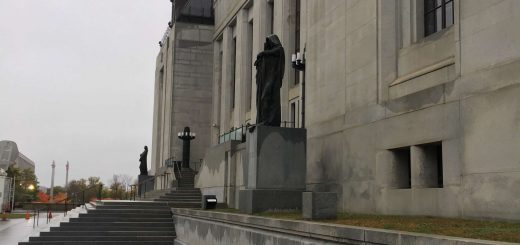A Double-Edged Sword: Bissonnette c. R.

The Court of Appeal’s (“CA”) decision in Bissonnette c. R., 2020 QCCA 1585 (“Bissonnette”), illuminated the importance of respecting Parliament’s authority to re-write legislation when a court declares a statute unconstitutional. This case concerns the events that occurred on January 29, 2017 at the Great Mosque of the Centre culturel islamique de Québec, where Alexandre Bissonnette, at the age of 27, carried out a premeditated attack on 46 citizens attending the mosque for worship that evening. At the trial, Bissonnette plead guilty to 12 counts: six counts of first-degree murder and six counts of attempted murder (Bissonnette, para 1).
The CA evaluates the provision set out in section 745.51 of the Criminal Code, R.S.C, 1985, c. C-46 (the “Code”), which stipulates ineligibility of parole that is allowed to be served for multiple murders. The CA looks at whether the Code’s provision is an infringement of section 7 and section 12 of the Canadian Charter of Rights and Freedoms (the “Charter”), and analyzes the trial judge’s decision to ‘read in’ and re-write section 745.51 rather than striking down the legislation.
The trial judge’s sentence of five concurrent minimum 25-year periods on counts 1-5, as well as an additional period of 15 years on count 6, means that Bissonnette would not be eligible for parole until he has served at least 40 years of his sentence (Bissonnette, para 3). The trial judge, Justice François Huot, makes reference to the Persian Letters in his opening statements, quoting Montesquieu: “Justice raises her voice, but she has difficulty in making herself heard amid the tumult of the passions.” This quote pays special homage now in the later stages of appeal, where the CA has truly taken a step back in order to evaluate the constitutionality of the law and its applicability to the circumstances.
Section 745.51 of the Criminal Code
The central focus of the appeal is section 745.51 of the Criminal Code:
At the time of the sentencing under section 745 of an offender who is convicted of murder and who has already been convicted of one or more other murders, the judge who presided at the trial of the offender or, if that judge is unable to do so, any judge of the same court may, having regard to the character of the offender, the nature of the offence and the circumstances surrounding its commission, and the recommendation, if any, made pursuant to section 745.21, by order, decide that the periods without eligibility for parole for each murder conviction are to be served consecutively.
This provision gives the judge the discretion to impose consecutive ineligibility periods. Under the provision, an offender who commits three counts of first-degree murder could potentially serve 75 years sequentially, without the ability to apply for parole, regardless of any efforts to rehabilitate. The purpose of this provision, as described in the Parliamentary Debates in 2011, carries two legislative objectives: “(1) to protect society from the most incorrigible killers,” such as serial killers like Robert Picton, Clifford Olson and Paul Bernardo, and “(2) to restore the balance between the rights of victims and those of multiple murderers and acknowledge the value of every life lost” (Bissonnette, paras 129, 134 and 135).
The Trial
At the trial, the Crown requested that Bissonnette’s sentence imprison him for six consecutive 25-year periods of parole ineligibility, resulting in a total of 150 years (Bissonnette, para 18). In reviewing the provision, Justice Huot indicated that he was required to impose a sentence that was proportionate both to the gravity of the offences and to Bissonnette’s degree of responsibility.
Justice Huot ultimately decided that section 745.51 of the Code was unconstitutional. However, instead of declaring the provision invalid, he felt it appropriate to read in new wording to allow a court to impose consecutive periods of less than 25 years (Bissonnette, para 36). In coming to this decision, Justice Huot took into consideration the defendant’s age since a total eligibility period for parole that would exceed the accused’s life expectancy would, “fully exhaust the utilitarian and normative goals of sentences” (Bissonnette, para 26). The trial judge concluded that protection of human dignity was a principle of fundamental justice that was infringed by allowing for sentences that would have a grossly disproportionate negative impact on the accused’s hope of one day being eligible for parole.
In deciding not to declare the provision constitutionally invalid, but that it was appropriate to read in new wording, Justice Huot deemed it appropriate to impose the discretion upon judges to impose periods of ineligibility that could total 25 to 50 years, as opposed to 25 or 50 years. The trial judge re-wrote the provision in terms that he viewed Parliament should have done to preserve the “principles of proportionality, totality of sentences, protection against overbreadth or grossly disproportionate impacts and the preservation of human dignity” (Bissonnette, para 38).
Court of Appeal: Review of the Issues
Following the sentencing judge’s decision, the Crown appealed the finding of unconstitutionality. Bissonnette appealed the sentencing judge’s remedy, to which the Crown defended as an alternative, and filed a motion to adduce new evidence.
Fresh Evidence
A minor segment of the appeal dealt with the request that the Court accept the filing of fresh evidence, which included a compilation of videos filmed at the Quebec City mosque in an attempt to reassert Bissonnette’s argument that he was careful not to harm any children. This evidence, if accepted, would be used to attempt to show that the trial judge erred in his assessment of an aggravating factor, involving the young age of the victims, used towards Bissonnette’s sentence and finding of criminal responsibility. Justice Doyon, alongside Justices Gagnon and Bélanger for the CA, found that the new evidence as a whole and in conjunction with the guilty plea, did not show that the appellant avoided his attempt to kill the young victims and therefore dismissed this motion.
Constitutionality
Justice Doyon examined the constitutionality of section 745.51 of the Code and dealt with the infringement of each Charter right separately. The stacking of sentences not being required by the statute, and the availability of this option at the discretion of the sentencing judge, was found to not remedy the constitutional defect. Therefore, the CA looked specifically at whether:
In and of itself, a sentence of imprisonment for life, without the possibility of parole before a period of 50, 75, 100 or 125 years, or even longer, represents, by its very nature or because it is grossly disproportionate, dehumanizing treatment that is intrinsically cruel and unusual within the meaning of section 12 of the Charter or that infringes the right to life, liberty and security of the person within the meaning of section 7 (Bissonnette, para 53).
In his analysis, Justice Doyon reminds us that even, “the worst criminal having committed the most heinous of crimes benefits at all times from the rights guaranteed under the Charter” (Bissonnette, para 72).
Section 12
Justice Doyon dealt with section 12 first and found the ability of a provision to set an order that can never be carried out, such as a parole eligibility period that will arrive after the offender’s death, brings the administration of justice in disrepute (Bissonnette, para 93). The senselessness in the basis of the judicial decision to confine someone to imprisonment for 75 or 100 years, which it is likely the offender will not outlive, is in and of itself cruel and unusual punishment that is degrading because of its absurdity (Bissonnette, para 107). The problem further extends beyond irrationality and has to do with the possibility that a rehabilitated offender could be denied the opportunity to apply for parole and this in and of itself is a constitutional flaw (Bissonnette, para 107).
Section 7
Justice Doyon also agreed with the trial judge that section 745.51 of the Code infringes section 7 of the Charter and restated the reasons provided by Justice Huot such as the violation of bodily integrity and severe psychological stress caused by deprivation of the offender’s security in serving multiple periods of parole ineligibility, as well as the deprivation, and separation from loved ones (Bissonnette, para 117). The question left to be decided by the CA was whether the rights are restricted in accordance with the principles of fundamental justice (Bissonnette, para 118). The Court of Appeal looked at the principles of overbreadth and gross proportionality relative to the statute’s objectives. The CA found the stacking of parole ineligibility sentences to be overbroad “because it applies to all multiple murderers, regardless of the specific circumstances of each case,” and therefore the rule produces effects not rationally connected to its objectives (Bissonnette, para 139). The sentencing was also found to be grossly disproportionate and held that they could not be saved by section 1 justification of the Charter.
Reading-In vs. Statement of Invalidity
The Court of Appeal did not approve the remedial measure used by the trial. Justice Huot read in a discretionary power to impose periods of less than 25 years to the legislation when it was clear that Parliament did not intend to give this type of discretion to sentencing judges. The CA held that the means chosen by Parliament, fixed periods of 25 years before parole eligibility, are central to the purpose of the law: “impose harsher sentences, so as to bolster the objectives of denunciation and retribution and, especially, thereby ensure the protection of society” (Bissonnette, para 169). In this way, the measures in drafting by Parliament are so, “inextricably bound up with that objective…that they cannot be disregarded without unduly intruding on the legislative sphere” (Bissonnette, para 169). In coming to this conclusion, the Court of Appeal reviewed the Parliamentary Debates and preamble to the legislation, to determine that the 25 year “leaps” are part of the objective. The Court of Appeal declared section 745.51 of the Code invalid by striking it down immediately for Parliament to rewrite.
Commentary
The unanimous CA spoke to the purpose of section 745.51 of the Code, which is not to sentence the offender for life but to prevent the Parole Board from exercising its discretionary power to release the offender on parole for periods of 50, 75 or 100 or more, rather than 25 (Bissonnette, para 69). While the interpretation of section 745.51 of the Code did not pose a problem, the Court acknowledged that Parliament had never before contemplated a minimum period of detention for as long as 50 years and more and therefore, the aforementioned provision of the Code has significantly changed things to an extent that now it is recognized as an important constitutional challenge (Bissonnette, para 72).
The importance of assessing individual cases based on their facts, and not in the abstract, plays an significant role in the justice system, as reflected in this case, where the consequences of the offender’s actions resulted in a particularly horrific aftermath that brought pain and suffering to many. While the remedy chosen was correct in respecting Parliament’s position to re-address the legislation, the CA may have taken too much of a step back in stating, “the analysis of the provision’s constitutionality must be carried out independently of the appellant’s case.” In R v Smith 1 SCR 1045, the Supreme Court’s first explication of section 12 of the Charter, Justice Lamer (as he then was) wrote,
In assessing whether a sentence is grossly disproportionate, the court must first consider the gravity of the offence, the personal characteristics of the offender and the particular characteristics of the case in order to determine what range of sentences would have been appropriate to punish, rehabilitate or deter this particular offender or to protect the public from this particular offender (Smith, para 1073).
In this regard, section 12 ensures that the sentence is not grossly disproportionate to the particular crime and circumstances, however it still allows for what is adequate as a consequence for the offender’s actions and the protection of the society. The CA failed to determine what range of sentences would be appropriate to rehabilitate, punish and deter an offender involved in a circumstance resembling mass murders. This case may be one to watch in its appeal to the Supreme Court, which will likely be granted to determine this novel constitutional challenge and guidance on the scope of judicial discretion in sentencing.








Join the conversation